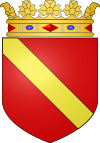Jean de Noailles
Jean-Louis-Paul-François de Noailles, 5th Duke of Noailles (26 October 1739, Paris – 20 October 1824) was a French nobleman and scientist.
Biography
Jean-Louis-Paul-François de Noailles was the son of Louis, 4th duc de Noailles. He was in the army for a period. However, his eminence as a chemist gained him the election as a member of the Académie des sciences in 1777. He was also a Knight of Golden Fleece.
He became Duc d'Ayen in 1766 on his grandfather's death, and Duc de Noailles on his father's in 1793. Having emigrated in 1792, he lived in Switzerland until the Bourbon Restoration in 1814, when he took his seat as a Peer of France.
His first wife, Henriette-Anne-Louise d'Aguesseau, bore him eight children:
- Adrien Paul Louis (17 September 1756 – 7 September 1757)
- Anne Jeanne Baptiste Louise (11 November 1758 – 22 July 1794), who married her cousin the Louis-Marie, the Vicomte de Noailles
- Marie-Adrienne-Françoise (2 November 1759 – 24 December 1807), who married Gilbert Du Motier, Marquis de Lafayette
- A daughter (born and died 11 December 1760)
- Françoise Antoinette Louise (3 September 1763 – 3 August 1788), Comtesse de Thezan du Pourjol
- Anne Paule Dominique (22 June 1766 – 29 January 1839), Marquise de Pouzols, Marquise de Montagu
- Angélique Françoise d'Assise Rosalie (1 August 1767 – 16 February 1833), Marquise de Grammont
- Louis Gabriel (19 August 1768 – 26 July 1770)
As a member of the royal military the Duke was away from his estates during much of the French revolution and was not present for the death of his father, upon which he became the Duc de Noailles. His absence spared him being arrested along with most of his relatives on orders of Robespierre in May 1794. On 22 July that year his 70-year-old mother (the dowager Duchess Françoise de Noailles), his wife (the Duchess Anne-Louise-Henriette), their eldest daughter Louise (the Vicomte de Noaille [by virtue of marriage to her cousin Marc Antoine de Noaille]), and their second daughter, Adrienne de La Fayette, were condemned to the guillotine. Adrienne was spared at the last moment, (possibly due to American intervention, as her husband was an fought for America during the American War for Independence) but only after her paternal grandmother, mother, and sister were beheaded within her sight. The Duke learned of their deaths weeks later. His family had lost many other members including two of his uncles and numerous cousins and in-laws during the Revolution.
The Duke went into self-imposed exile in Switzerland until the Bourbon Restoration, returning to France and his ravaged estates after Napoleon and the Directory restored some order. Through the efforts of his daughter Adrienne de La Fayette, whose husband's family also suffered greatly in the Revolution, some part of his once immense fortune was restored.
Although the Duke remarried in 1796 to the Baroness Wilhelmine Justine of Mosheim (Yury Golovkin's mother), he had no further children and was survived by only two of his eight children. Having no surviving sons and having survived his nephews, he was succeeded as duc de Noailles by his grandnephew, Paul.
References

- Information on the genealogy of this Noailles line
- Généalogie de Carné
| French nobility | ||
|---|---|---|
| Preceded by Louis |
Duke of Noailles 1793–1824 |
Succeeded by Paul |
| Preceded by Louis |
Duke d'Ayen 1766–1793 |
Succeeded by Paul |
